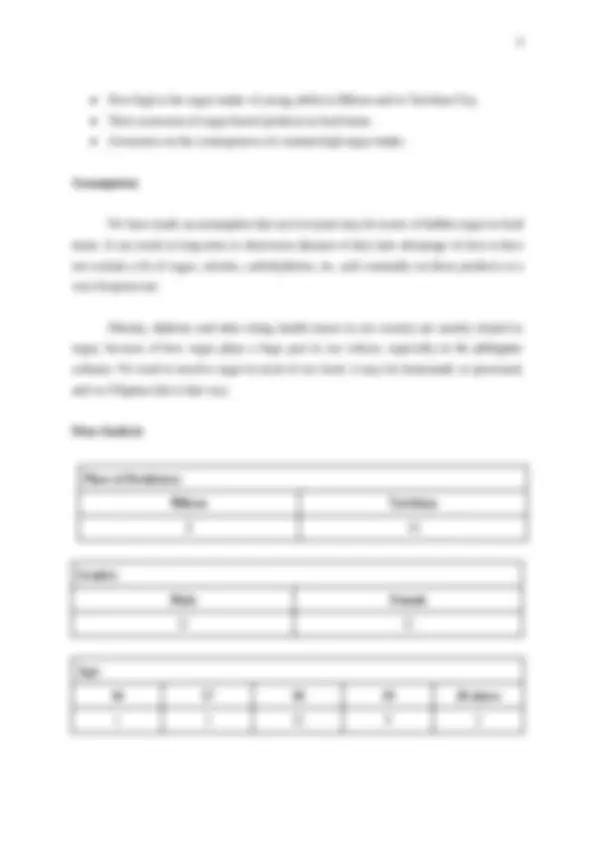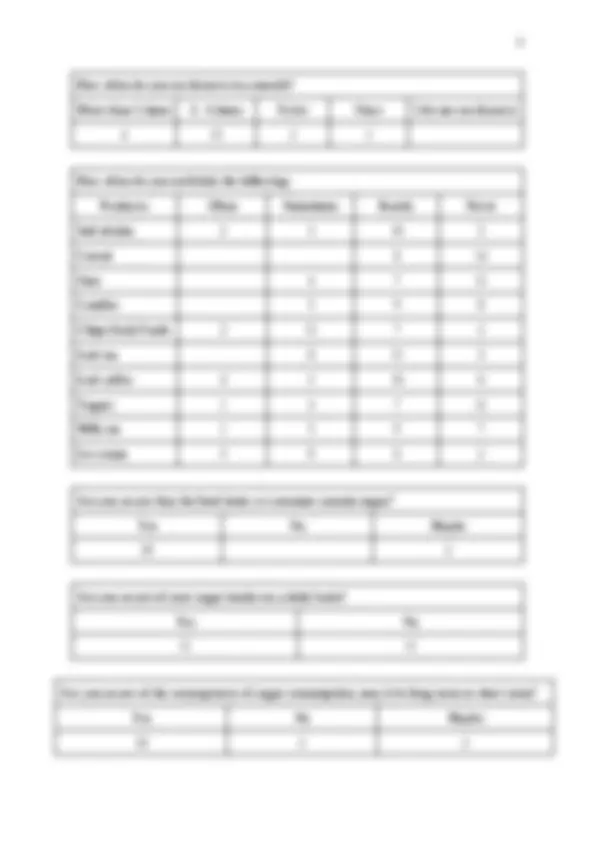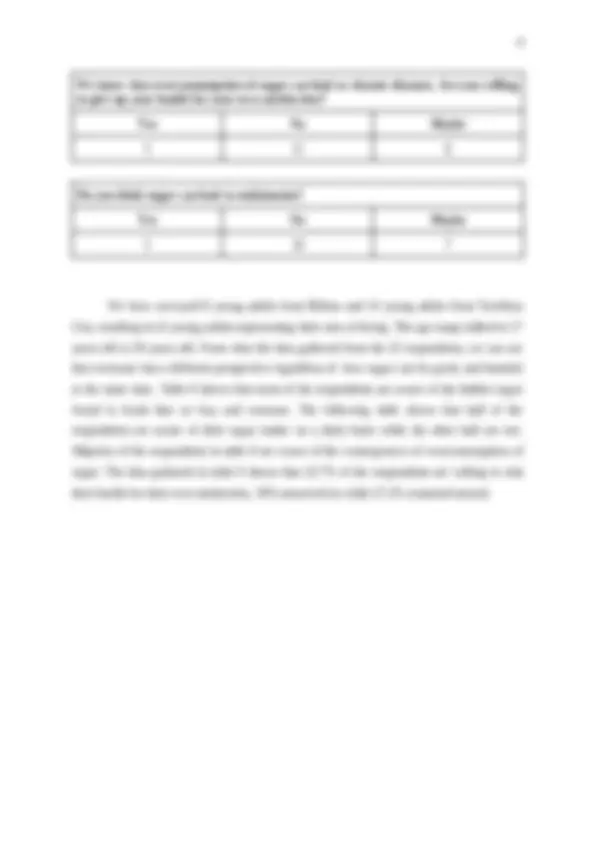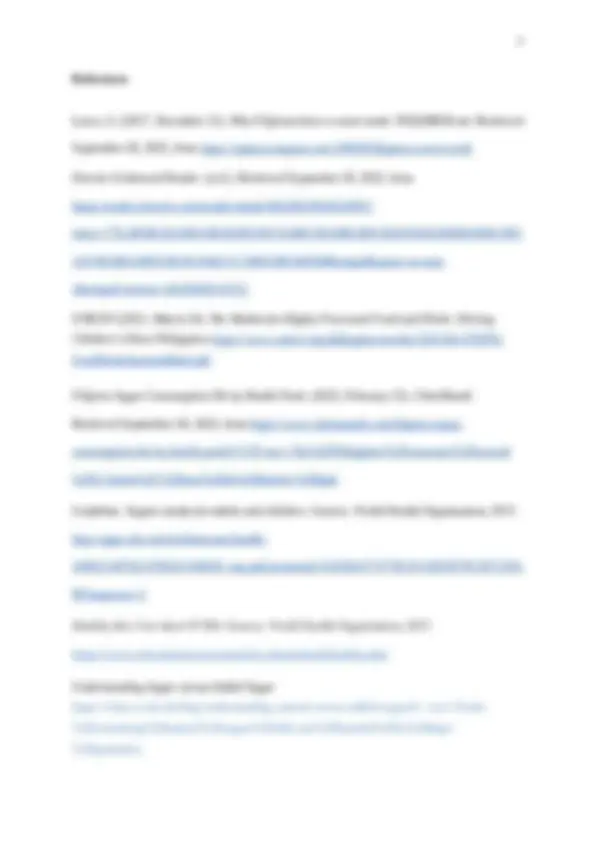







Study with the several resources on Docsity

Earn points by helping other students or get them with a premium plan


Prepare for your exams
Study with the several resources on Docsity

Earn points to download
Earn points by helping other students or get them with a premium plan
Community
Ask the community for help and clear up your study doubts
Discover the best universities in your country according to Docsity users
Free resources
Download our free guides on studying techniques, anxiety management strategies, and thesis advice from Docsity tutors
A case study was conducted by 2 accounting students in their Science, Technology, and Society project.
Typology: Study Guides, Projects, Research
1 / 9

This page cannot be seen from the preview
Don't miss anything!






School of Business and Economics Department of Accountancy The Sweet Danger of Sugar: A Case Study on Young Adults of Biliran and Tacloban City with their Awareness of Hidden Sugar in Food Items Submitted by: Abalayan, Jan Rissa M. Avila, Paula Nicole P. Submitted to: Mr. Melbert Ople September 29, 2022 Introduction
Young adults of our generation tend to consume more sugar than what is necessary. Likewise, sugar-containing beverages, and sugar-based foods are marketed ubiquitously through both traditional and new media platforms, in overt and subtle ways, and in environments popular with young people throughout the years (Brownbill, Miller, & Braunack-Mayer, 2018b; Eisenberg, Larson, Gollust, & Neumark Sztainer, 2017; Holmberg, Berg, Dahlgren, Lissner, & Chaplin, 2018; Holmberg, E. Chaplin, Hillman, & Berg, 2016). It has raised the concern that nearly one in ten teens currently suffers from overweight or obesity in our country (UNICEF, 2021). We ought to think of how the young adults of Biliran and Tacloban City manage their sugar intake and know if they see sugar as a need or as a pursuit of one’s pleasure and delight to eat sugar-based food products. After all, with the arising food innovations, creativity, and recipes of different cultures involving sweets. It can easily gain the attention of people how it is different from the usual that is seen. Even with the imported food products from other countries, they do still have hidden sugars regardless of saying it is sugar-free. Background Filipinos are known to have a massive sweeth tooth. Considering 2.5 tonnes of sugar consumption each year, we are one of the largest consumers in Asia, along with India, China, Indonesia and Thailand. The Philippines is very much part of sugar’s history, being in the region where sugarcane originated, and where sugar haciendas figured greatly in its colonial economy (“Filipino Sugar Consumption Hit by Health Push,” 2022). This heritage of sugar production hints at why Filipinos use sugar in everything: As historian John Larkin wrote, sugar manufacturers expanded the domestic market “by exciting the Filipino taste for their product” through ad campaigns and free packets of sugar. Sugar’s place as a status symbol, its sheer addictive quality, relatively cheap prices, and our being accustomed to high levels of it in our foods can thus explain why Filipinos have a sweet tooth (G. Lasco, 2017). It led the Philippine government to introduce a tax on sugar-sweetened beverages (SSBs) to reduce sugar consumption and target rising levels of obesity in 2018 (Czapp, 2022). Key Issues
How often do you eat desserts in a month? More than 5 times 3 - 4 times Twice Once I do not eat desserts 4 15 2 1 How often do you eat/drink the following: Products: Often Sometimes Rarely Never Soft drinks 2 5 10 5 Cereal 8 14 Oats 4 7 11 Candies 5 9 8 Chips/Junk Foods 2 11 7 2 Iced tea 8 11 3 Iced coffee 4 2 10 6 Yogurt 1 3 7 11 Milk tea 1 5 9 7 Ice cream 3 9 8 2 Are you aware that the food items we consume contain sugar? Yes No Maybe 20 2 Are you aware of your sugar intake on a daily basis? Yes No 11 11 Are you aware of the consequences of sugar consumption; may it be long term or short term? Yes No Maybe 18 2 2
We know that overconsumption of sugar can lead to chronic diseases. Are you willing to give up your health for your own satisfaction? Yes No Maybe 5 11 6 Do you think sugar can lead to eudaimonia? Yes No Maybe 5 10 7 We have surveyed 8 young adults from Biliran and 14 young adults from Tacloban City, resulting in 22 young adults representing their area of living. The age range tallied to 17 years old to 26 years old. From what the data gathered from the 22 respondents, we can see that everyone has a different perspective regardless of how sugar can be good, and harmful at the same time. Table 6 shows that most of the respondents are aware of the hidden sugar found in foods that we buy and consume. The following table shows that half of the respondents are aware of their sugar intake on a daily basis while the other half are not. Majority of the respondents in table 8 are aware of the consequences of overconsumption of sugar. The data gathered in table 9 shows that 22.7% of the respondents are willing to risk their health for their own satisfaction, 50% answered no while 27.2% remained neutral.
Production of sugar-based products by industries must be regulated. However, it is not just the industry to blame as it is their duty to meet demands. With people’s high demand for sugar-based products, the industry continues to produce more. Lack of discipline will result in the same give-and-take cycle, even though these products pose a threat to people’s health. Impact of Proposal in the Pursuit of Happiness Based on the data gathered, 22.7% of the respondents agreed that sugar can lead to eudaimonia. On the other hand, 45.4% disagreed while 31.8% of the respondents are unsure. Sugar has been linked with achieving eudaimonia. Eudaimonia, as defined by Aristotle, is a life well lived. But the happiness that sugar gives is not permanent. Although it gives a boost of good hormones, uplifts the mood, provides energy and makes you happy, these effects stay momentary. The journey towards living a good life does not rely on sugar consumption. In order to achieve happiness, we start by taking care of our health. Having good health will enable us to maintain good physical and mental health, and being physically, mentally, and emotionally healthy will lead to a happy life. A life well lived that we know is a healthy life. Our proposed alternative will serve as a guide to consumers of sugar who are unaware of the consequences of excessive sugar intake, as well as those who strive for a better lifestyle. Conclusion Majority of the young adults residing in Biliran and Tacloban City seem to be aware of the hidden sugar in food items, although we also cannot say with their sugar intake; as 50% of 22 participants cannot track their sugar on a daily basis. In one of the data gathered, we can also see that only 5.9% of the 22 participants eat high amounts of sugar in food items, they eat these food items oftenly, these can be soda, ice cream, etc. We have made further inquiries on our participants if ever they are aware of the consequences of eating too much sugar; 82% answered yes, 9% answered no, and 9% answered maybe. We can say that the young adults of Biliran and Tacloban City are aware of the consequences, the hidden sugar, and some are aware of their sugar intake.
References Lasco, G. (2017, December 21). Why Filipinos have a sweet tooth. INQUIRER.net. Retrieved September 26, 2022, from https://opinion.inquirer.net/109639/filipinos-sweet-tooth Elsevier Enhanced Reader. (n.d.). Retrieved September 26, 2022, from https://reader.elsevier.com/reader/sd/pii/S0020653920323091? token=77E280DED3A0BADE6D39D1B74A6BCD9A8BCB0F2E945FE6D4EB8D490CFB 14574E588A3B5F28C6C9A0CCC74B5CBED4DD8&originRegion=us-east- 1&originCreation= UNICEF (2021, March 24). The Market for Highly Processed Food and Drink: Driving Children’s Diets Philippines https://www.unicef.org/philippines/media/2201/file/UNIPH- FoodDrinkAnalysisBrief.pdf Filipino Sugar Consumption Hit by Health Push. (2022, February 15). ChiniMandi. Retrieved September 26, 2022, from https://www.chinimandi.com/filipino-sugar- consumption-hit-by-health-push/#:%7E:text=The%20Philippines%20consumes%20around %202.5,basis%2C%20near%20its%20historic%20high. Guideline: Sugars intake for adults and children. Geneva: World Health Organization; 2015 http://apps.who.int/iris/bitstream/handle/ 10665/149782/9789241549028_eng.pdf;jsessionid=D3F69A774778CD1AB5F079C567129A 08?sequence= Healthy die t, Fact sheet N°394. Geneva: World Health Organization; 2015 https://www.who.int/en/news-room/fact-sheets/detail/healthy-diet Understanding Sugar versus Added Sugar https://chear.ucsd.edu/blog/understanding-natural-versus-added-sugars#:~:text=Foods %20containing%20natural%20sugars%20offer,are%20harmful%20in%20large %20quantities.